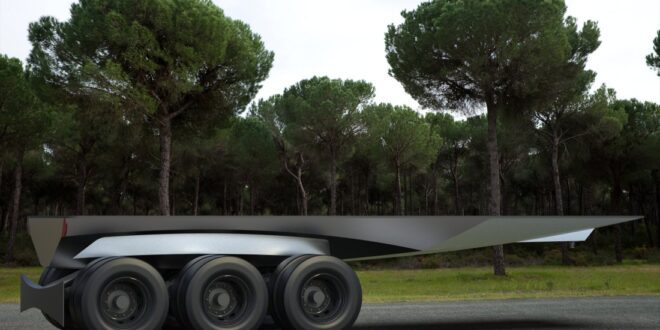New research has revealed that HGVs (Heavy Goods Vehicles) are responsible for nearly a fifth of domestic transport emissions in the UK and over a quarter across Europe. However, Swedish technology and design firm STILRIDE has developed a solution to reduce the environmental impact of heavy transportation – by constructing HGV semi-trailers using origami-inspired manufacturing technology. Known as STILFOLD, the proprietary sustainable manufacturing technology utilises robotic arms to fold steel over curves to create light and strong new structures, using minimal component parts. STILRIDE estimates that if used to build semi-trailers, STILFOLD could prevent up to 12,000 tonnes of CO2 from entering the atmosphere and remove the need for approximately 360,000 HGV journeys per year.
Methodology:
– Design: STILRIDE’s design team reimagined the traditional ladder frame used in semi-trailers, instead creating an “origami” exoskeleton using origami-inspired steel folding. The outer shell is composed of two steel sheets with one main weld and eight strategically-placed folds, giving the necessary structure and keeping the weight down.
– Performance: STILFOLD requires 90% fewer component parts than traditional models and can be constructed using 30% fewer materials. The trailer would weigh an estimated 2000kg less than traditional semi-trailers, weighing in at 6000kg. The designers aimed to simplify elements of the design and use fewer materials whilst retaining the trailer’s structural integrity; and to improve the trailer’s performance by reducing HGVs’ fuel consumption whilst enabling HGVs to carry heavier loads.
– Impact: Researchers analysed Swedish transportation data with a focus on the construction and mining sector. They found that if just 50% of the 7,346,000 yearly journeys within the mining and construction sector gained 2 tonnes of load capacity each year, this would create a load increase of 7,346,000 tonnes which represents 5% of the total yearly tonnage transported within the mining and construction sector in Sweden. STILRIDE estimates that this load increase could mean 360,000 heavy load journeys could be prevented each year, preventing 12,000 tonnes of CO2 from entering the atmosphere annually.
Jonas Nyvang, CEO and co-founder at STILRIDE, stated that the technology could significantly reduce HGVs’ impact on the environment by rethinking how semi-trailers are used and produced through innovative design. Henrik Sieurin, Expert Engineer at Scania, also commented that replacing the traditional ladder frame trailer with STILFOLD structure could reduce fuel consumption and increase load carrying capacity, thereby reducing the environmental impact of heavy transport. While STILRIDE’s immediate focus is on its first electric motorbike, the company hopes to bring innovations including a sustainable steel semi-trailer to market in the future.
 Mind Uncharted Explore. Discover. Learn.
Mind Uncharted Explore. Discover. Learn.




